Kinetic Chain

If you’ve ever been to rehab or received personal training at a gym, you’ve probably heard of the ‘kinetic chain.’ You might also have heard phrases like ‘open kinetic chain’ and ‘closed kinetic chain.’ So, what exactly is the kinetic chain?
The kinetic chain was first described by mechanical engineer, Franz Reuleaux. Reuleaux believed that all machines can be simplified into chains of individual links called kinematic pairs. This offered a new method of studying machines and advanced technology to develop more progressive mechanical machinery. Reuleaux further added that putting together multiple kinematic pairs was the movement of a kinetic chain.
Years later, Dr. Arthur Steindler expanded upon Reauleax’ work and applied this concept to the human body and exercise. He introduced the concept of open and closed kinetic chain in order to differentiate between two different exercises approaches.
CLOSED KINETIC CHAIN
Steindler reported that the body can be thought of as a system of rigid segments connected by a series of joints. He defined the closed kinetic chain as a condition in which the terminal segment meets considerable resistance. In other words, the distal end of the extremity is fixed to the environment. Examples of closed kinetic chain exercises include:
- Squats
- Lunges
- Push-ups
- Pull-ups
OPEN KINETIC CHAIN
Opposite of closed kinetic chain exercise is the open kinetic chain exercise. Described by Steindler as a motion where the terminal segment was free to move in space. So the distal end of the extremity is not fixed to an object. Examples of open kinetic chain exercises include:
- Leg press
- Leg curls
- Bench press
- Lat pull-down
So what does the concept of the kinetic chain have to do with your health and understanding of musculoskeletal injuries? Simply put, this concept helps inform us that joints in the body can cause dysfunction elsewhere in the body. For example, how the foot can affect the ankle and knees, how the thoracic spine can affect the shoulder joint, or how the position of the pelvis can affect the hip and low back.
The concept of the kinetic chain, in the human body, addresses only certain joints such as the ankle, knee, hip, elbow, and shoulder joint, but the human body is not such a simple machine. There are many other structures that influence each link (or joint). Some of these structures include muscle, tendon, ligaments, and fascia. Muscles and other soft tissue in our bodies are not independent of our bony skeleton and its joints. So in order to address the ENTIRE kinetic chain, muscle flexibility, joint capsule tightness, and fascia restrictions, along with the bones and joints, have to be considered.